Looking back over 1993, I’ve found it was quite an auspicious year for movies. It was in ‘93 that the decade’s most prominent blockbuster (JURASSIC PARK) and its most notorious flop (LAST ACTION HERO) appeared, in addition to a number of iconic movies (GROUNDHOG DAY, SLEEPLESS IN SEATTLE, DAZED AND CONFUSED, TRUE ROMANCE, THE NIGHTMARE BEFORE CHRISTMAS) that continue to be referenced today. From a personal standpoint I’ll have to say that ‘93’s movies may just outdo those of 1994 (which I’ve long believed was the decade’s “best” year for movies) in quality and interest.
Of course, that sentiment only applies to the thirty odd, obscure and underappreciated films included below. As anyone who’s recently tried watching THE FIRM, DAVE, IN THE LINE OF FIRE or THE PELICAN BRIEF can readily attest, most of the year’s big ticket items haven’t dated well at all. The same is true of once-popular cult films like ARMY OF DARKNESS, SUPER MARIO BROS. and CARNOSAUR, and also the fabled train wreck scene in THE FUGITIVE, which was considered so mind-blowing that back in my movie theater projectionist days I recall people buying tickets to the film just to experience the sequence in question, but now…
Anyway, here’s the list…
30. THE DEAD MOTHER (LA MADRE MUERTA)
A well-made, dark-humored and fitfully perverse Spanish thriller from director Juanma Bajo Ullao (AIRBAG). An unwieldy prologue finds a sociopath named Ismael (Karra Elejalde) robbing a house, killing its owner and confronting the young Leire. Years later Ismael recognizes the now grown-up—and mentally impaired—Leire (Ana Alvarez) in an institution and kidnaps her. He’s aided by his equally cracked GF (Lio), who wants to ransom their captive off immediately; Ismael though finds himself falling in love with Leire, much against his will. There are quite a few glaring plot holes and inconsistencies (it’s odd that by the film’s third act nobody has thought to clean up the glass from a window broken in the first), but impressive camerawork and some clever suspense sequences make for a worthwhile viewing experience.
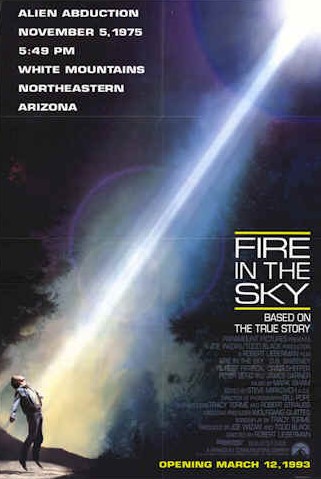 29. FIRE IN THE SKY
29. FIRE IN THE SKY
This movie, adapted from an allegedly nonfiction book, has gotten a bad rap, but in the field of “fact” based UFO abduction books/films it’s a definite standout. FIRE IN THE SKY’S overall problem is that the brief UFO abduction it depicts (like those of the INTERRUPTED JOURNEY and COMMUNION books/films) isn’t substantial enough to power an entire movie. Nonetheless, director Robert Lieberman manages to keep the proceedings, which pivot on potentially snooze-worthy elements like a mass lie detector test and endless searches for the abductee (D.B. Sweeney), lively and involving, and doesn’t wimp out in his depiction of the movie’s raison d’etre. This is to say that the alien abduction, shown in the final twenty minutes, isn’t depicted through subtle or “suggestive” means, but in a full-bodied special effects packed mélange of slime, otherworldly set design and a pair of profoundly ugly extraterrestrials. Obviously this sequence is no longer as startling as it seemed back in ‘93 (when I made sure to view it over and over while projecting the film), but it remains an eye opener.
28. THE CORMORANT
A chilly and disquieting BBC telefilm, adapted from the popular novel by Stephen Gregory and starring a young Ralph Fiennes. It concerns an evil bird, but not of the standard THE BIRDS/JAWS variety, as the horror here is of a far stranger and more insidious sort. Fiennes plays a dude who inherits a rural cottage from his deceased uncle, along with a nasty cormorant that exerts a malevolent influence over him and his young son. The pic has an admittedly tacky, low budget BBC look—marked by muted colors and sparse lighting—but it succeeds nonetheless. This is due in no small part to Ralph Fiennes, who conveys an unforgettable portrait of obsession and madness. The cormorant for its part is also quite impressive; it can’t have been easy getting the bird to perform, but it showcases an impressive range of movement and expression.
27. GERMINAL
This French period epic was based on a novel by Emile Zola, and brings the author’s fiery political sentiments to vivid cinematic life. JEAN DE FLORETTE’S Claude Berri gives this gritty tale a fine, crisp look, with set design that never feels less than authentic. Berri also pays proper lip service to Zola’s narrative, which contains a variety of characters and incidents that are almost Dickensian in their richness. Among the actors are Gerard Depardieu as a hardened miner and Miou-Miou as his long-suffering wife; I never quite understood how it was that Depardieu was supposed to be a starving laborer when he’s visibly overweight, but oh well. His acting is quite good, at least, and Berri does a fine job elucidating the concerns of both the miners, who stage a mass strike, and their superiors, who can’t afford to raise their workers’ salaries. Ultimately the revolt fails, turning into a destructive melee that concludes with the mines being flooded and several pivotal characters dying. I found the final scenes unnecessarily drawn-out and self-conscious; despite Berri’s epic tapestry the near-three hour runtime feels a bit excessive.
26. THE RED SQUIRREL (LA ARDILLA ROJA)
An early work from Spanish filmmaker Julio Medem, a highly elliptical yet oddly compelling account of star-crossed lovers. THE RED SQUIRREL never quite comes together in the way other Medem offerings like TIERRA and LOVERS OF THE ARCTIC CIRCLE do, but it’s a fascinating oddity. A has-been singer (Nancho Novo) is the lone witness to a motorcycle accident by an attractive woman (Emma Suarez); luckily for Novo she survives the crash, but with amnesia, allowing him to invent a name for her, pose as her boyfriend and fabricate a past life. Inevitably, though, a figure from the woman’s past comes back to throw Novo’s carefully constructed ruse into disarray. Medem’s colorful and precise visual style is among the most distinctive in modern cinema, and he was working at (nearly) full throttle here. Plus, Ms. Suarez in 1993 was simply the most striking and compelling Spanish actress to hit screens since the glory days of Victoria Abril.
 25. THE BABY OF MACON
25. THE BABY OF MACON
Easily the most grotesque, Satanic, mean-spirited film ever made by England’s Peter Greenaway. A decrepit old woman gives birth to a baby with magical powers. The woman’s virgin daughter (Julia Ormond) claims the baby as her own, has her ma locked up and uses the kid for her personal gain. The church further exploits the B of M by selling its blood, leading Ormond to murder the child in a jealous rage. The church wants to execute Ormond, but their own laws prohibit killing a virgin—the solution: every man in town is called upon to rape her. It’s a good thing the film is done up in the style of a medieval morality play, complete with a vocal—and clearly visible—audience, thus keeping the unpleasantness somewhat in check (and providing a rather sophomoric reality-versus-illusion angle). Like all Greenaway’s work, it’s a beautifully composed, exquisitely stylized film, yet it left me a bit cold. Whether it’s the deliberately artificial atmosphere or the sorely missed music of Greenaway’s favorite composer Michael Nyman (the two had a falling out on PROSPERO’S BOOKS), something is clearly missing. Still, the sight of a fully nude Ralph Fiennes getting gored by an angry bull is more than worth the price of admission.
24. SEX OF THE STARS (LE SEXE DES ETOILES)
This French-Canadian drama once seemed like a particularly outrageous fantasy about a “taboo subject.” It concerns a teenage girl (Marianne Coquelicot Mercier) attempting to deal with the fact that her long-distant father has had a sex change operation, and is now a woman. Good performances all around, particularly Denis Mercier as the transsexual, who is treated as neither a freak nor a heroic outcast but, rather, as a sincere, if undeniably flawed, individual. What really gives this film its distinction is the darkly seductive and somewhat elliptical filmmaking by director Paule Baillargeon, which appears to have been inspired by the work of her fellow countryman Atom Egoyan (there’s even a flamboyant nightclub that closely prefigures that of EXOTICA), and lends an added dimension to what would have otherwise played like a glorified TV movie.
23. DARR
The very definition of excess, a Bollywood thriller that was apparently conceived as a rip-off of SLEEPING WITH THE ENEMY but ended up a thoroughly nutty concoction that cribs from nearly every stalking movie ever made, and does so over a highly expansive three hour canvas. That producer/director Yash Chopra manages to sustain one’s interest throughout is perhaps the film’s most impressive achievement. It’s also a blast seeing the baby-faced Shah Rukh Khan, the so-called “King of Bollywood,” playing a psychopathic nut. He’s besotted with a college classmate (Juhi Chawla) who’s in love with a studly naval officer (Bollywood action superstar Sunny Deol). Essentially, Khan harasses his beloved by phone and ingratiates himself into her and Deol’s lives, eventually going full tilt schizo and precipitating a violent CAPE FEAR-esque boat-set climax. Also featured are the requisite large-scale song and dance numbers and a number of violent action set-pieces, all pitched at an emotional level that makes most soap operas seem restrained.
22. POINT OF NO RETURN
Now here’s a major shocker: this, the cynical Hollywood remake of Luc Besson’s French hit LA FEMME NIKITA (1990), has actually aged better than its inspiration. This is a development I definitely couldn’t have predicted back in ‘93, when I was huge fan of NIKITA and thoroughly appalled by POINT OF NO RETURN. Nowadays, however, I find Besson’s film pretty dreary, a stylish but fatally lopsided work enlivened by two decent-but-unremarkable action sequences that both occur in the first half, after which it dies down. POINT OF NO RETURN maintains its equilibrium from start to finish, although its true selling points, I’d argue, are the many quirky elements included by director John Badham, which stand in stark contrast to the single-mindedness of NIKITA. Those elements include an oddly wistful Hans Zimmer score packed with vintage Nina Simone tunes and the casting of Bridget Fonda, who exudes positive energy and a good natured sexiness—not exactly qualities you’d expect from the psycho junkie turned remorseless assassin she plays, but pleasingly unexpected nonetheless.
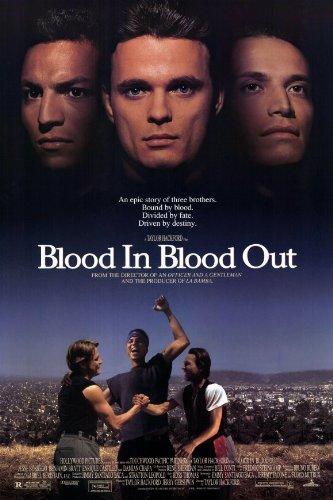 21. BLOOD IN, BLOOD OUT (BOUND BY HONOR)
21. BLOOD IN, BLOOD OUT (BOUND BY HONOR)
The second of two competing East L.A.-set early nineties Hispanic crime epics, the first being AMERICAN ME. That film, directed by Edward James Olmos, was gritty and naturalistic, while this Taylor Hackford helmed effort is extremely jazzy and flamboyant. Subtlety is nowhere to be found; the performers were evidently encouraged to emote as histrionically as possible, and Hackford never misses a chance to heighten the melodrama. Inspired by the life story of poet Jimmy Satiago Baca, who co-wrote the screenplay, it centers on three Latino friends (Jesse Borrego, Benjamin Bratt and Damien Chapa) whose lives take very different paths after a tangle with the law. One of them (Chapa) goes to prison, another (Bratt) joins the police force, and the third (Borrego) manages to elude the law and become an acclaimed artist. Over the course of a three hour-plus runtime Chapa becomes a big shot in prison while Bratt zeroes in on his former amigos, and so finds himself in a moral quandary. The film is fast moving and entertaining, although the oddly subdued L.A. reservoir-set coda isn’t entirely satisfying.
20. FEARLESS
Now here’s something you definitely haven’t seen before: a film that explores, up close and personal, the effects of post-traumatic stress disorder. The sufferer is a San Francisco architect (Jeff Bridges) who survives a plane crash and emerges with a severe God complex. After selling out with DEAD POETS SOCIETY and GREEN CARD, the great Peter Weir returned in FEARLESS to the visionary turf of his early films PICNIC AT HANGING ROCK and THE LAST WAVE. Its major failing is one that afflicts quite a few Hollywood films: its laughable portrayal of everyday “reality,” as represented by the many recognizable supporting players the film tries to pass off as normal San Franciscans and the decidedly unconvincing portrayal of Bridges’ job as a San Francisco architect (which apparently affords him endless amounts of free time). But the opening scene of Bridges exiting a cornfield where his flight just crashed and the final terrifying flashback to the event itself are amazing examples of visionary cinema, and like nothing else in contemporary film.
19. CITY UNPLUGGED (TALLINN PIMEDUSES)
This darkly comedic “Spaghetti Eastern” was Estonia’s answer to RESERVOIR DOGS. It’s dark, funny, energetic and sometimes shocking—the opposite, in short, of what we’ve come to expect from cinema in this part of the world (fact: Estonian cinema has apparently come to mean “slow, arty and obscure”…by residents of Estonia!). It opens with a lengthy text informing us that a stash of Estonian gold is currently being transported from France to its rightful home. From there we’re introduced to Toivo (Ivo Uukkivi), a petty smuggler who allows himself to be roped into a half-baked gambit to rob the Bank of Estonia, carried out while hundreds of people are gathered outside in anticipation of the gold stash’s arrival. The production values are nothing to write home about, and the fights and shoot-outs that come to increasingly dominate the film are only partially effective, marred by an extremely clumsy use of slow motion. Yet the whole thing is so inventive it’s difficult not to get caught up in it. Director Ilkka Jarvi-Laturi also demonstrates a mastery of tone, which is comedic but never too much so; as in Tarantino’s films there are very real, and very nasty, consequences for misbehavior.
18. THE UNTOLD STORY (BAT SIN FAN DIM: YAN YUK CHA SIU BAU)
One of the most violent movies I’ve ever seen, this fact based Hong Kong production deserves points for, if nothing else, its sheer audacity. It also features a downright terrifying performance by Anthony Wong as a nerdy psychopath who takes over a restaurant after the original owner and his family all mysteriously “disappear.” Actually, Wong has killed and mutilated them all, in a truly hideous sequence that we see enacted step by winsome step. From there Wong commences killing everything that moves, from a dude he sets on fire to a woman he brutally rapes and then offs via a handful of uncooked noodles (jammed in a particularly sensitive place!). He later dismembers his victims and grounds up their remains (once again, we get an up-close view of the process) for the pork buns he serves—of which his customers can’t get enough. As I said, the film is extremely violent but also quite well made, delivering a powerful cinematic kick in the gut, although I could have done without the lame comic relief from the bungling cops on Wong’s trail.
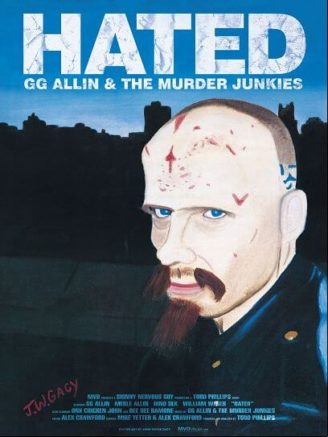 17. HATED: GG ALLIN AND THE MURDER JUNKIES
17. HATED: GG ALLIN AND THE MURDER JUNKIES
Until his 1992 OD the rocker GG Allin was one of the biggest freaks on the planet, and this 50-minute documentary look at his final days exerts an undeniable train wreck fascination. Todd Philips (who would follow HATED with the equally corrosive doco FRAT HOUSE) made this as an NYU film major, and it went on to become the highest grossing student film of all time. From a technical standpoint it’s pretty standard stuff, alternating talking heads with dispassionate voiceovers and video footage of Allin’s outrages. That latter category includes copious puking and bleeding, rounded out with some pretty incredible documentation of Allin’s final concert, during which he smears excrement on his naked body, physically attacks audience members and causes a riot when he hits the streets of NYC and lies down in front of a bus—unsurprisingly, he died later that same night.
16. CONVERSATION WITH A CUPBOARD MAN (ROZMOWA Z CZLOWIEKIEM Z SZAFY)
Poland’s Mariusz Grzegorek made his feature film debut with this masterly, if incomplete, adaptation of Ian McEwan’s famed story “Conversation with a Cupboard Man.” Impeccably performed and photographed, it features a boy raised by his demented mother (Bozena Adamek) to be a severely maladjusted man-child (Rafal Olbrychski) who struggles to fit in with a society he doesn’t understand, and eventually perpetrates a horrifically violent act upon his asshole boss (Adam Ferency). Grzegorek helms with a sure and confident hand that belies his amateur status, and evinces a real flair for surrealism in the many dream sequences—in which the protagonist’s incestuous feelings for his mother are made evident. My only problem with the film is the fact that Grzegorek follows the McEwan text quite closely yet inexplicably leaves out its ending; the film concludes with the climactic assault, which fails to properly close out the twisted mother-son relationship that drives the narrative.
15. FREAKED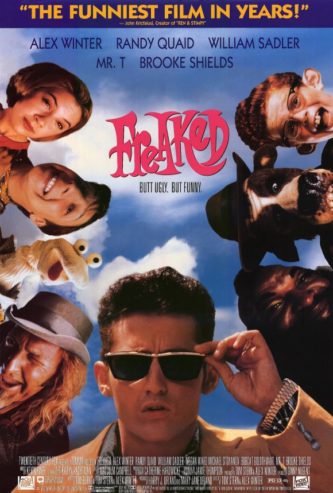
A demented comedy so astoundingly lightweight that a definite mental adjustment is required on the part of the viewer, as FREAKED makes most Zucker bros. comedies look like Ingmar Bergman dramas in comparison. Co-director Alex Winter stars as a former TV star employed by a corrupt chemical corporation who visits an obscure South American freak show. The show’s mad scientist proprietor (Randy Quaid) turns Winter into a freak via the chemical Winter is being paid to promote, making him part of the show. Also featured are Mr. T as a bearded lady(!), Bobcat Goldthwait as a human sock puppet, a dorky kid who gets turned into a Robert Williams-esque monstrosity, two massive gun-toting eyeballs and Brooke Shields as a seemingly benign talk show host. It’s all quite funny once the viewer adjusts to the uber-goofiness, and the elaborate make-up effects by Screaming Mad George are impressive.
14. BODIES, REST & MOTION
Easily the strongest of the many Gen-X skewering movies released during the early-to-mid nineties (SINGLES, REALITY BITES, SLEEP WITH ME, etc.), even though it was based on a play written back in 1988. BODIES, REST AND MOTION actually plays like a loose adaptation of Douglas Coupland’s GENERATION X (the novel that gave my generation its name and identity), being an exceedingly stylish and well-acted piece that actually manages to make its cast of twentysomething do-nothings seem interesting. Bridget Fonda is the lead (more or less) and, in addition to looking great in a variety of skimpy outfits, creates a surprisingly ingratiating portrayal of a young woman who lives her life according to whatever her boyfriend of the moment demands. There’s also Tim Roth as Fonda’s a-hole ex, Phoebe Cates as her best friend who’s now dating Roth, and Eric Stoltz as a pothead painter who gums everything up. The setting is a superbly atmospheric portion of Phoenix, AZ, which with its parched, sunbaked landscapes effectively mirrors the shiftless characters.
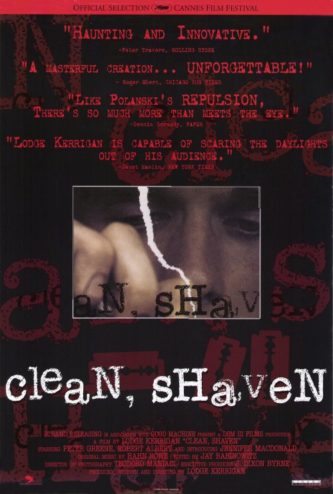 13. CLEAN, SHAVEN
13. CLEAN, SHAVEN
Lodge Kerrigan made a stunning debut with CLEAN, SHAVEN, a powerful look at the workings of a disturbed mind. Peter Greene plays a schizophrenic man who may or may not be responsible for the killings of several children making his laborious way to the home of his ex-wife to see his young daughter (Jennifer MacDonald). Kerrigan employs a barrage of sound effects—radio feedback, static, disembodied voices—in addition to a collage-like visual style to illustrate Greene’s deteriorating mental state, and executes it all with breathtaking skill. There’s also a truly grotesque fingernail ripping scene that reportedly made a number of women faint at Sundance. The film, however, belongs to Greene, who creates a character at once menacing and deeply tragic, which led to lengthy career playing scumbags (most memorably Zed the rapist in PULP FICTION).
12. BODY SNATCHERS
The second remake of INVASION OF THE BODY SNATCHERS and, if you ask me, the best. Initially conceived as a project for Stuart Gordon (who retains a screenwriting credit), the film ended up directed by, unexpectedly enough, Abel Ferrara, who turned out to be the correct choice. In contrast to Philip Kaufman’s glitzy San Francisco set INVASION OF THE BODY SNATCHERS from 1978, Ferrara returns the material to its down-and-dirty low budget origins. The setting is a tightly knit military community whose code of rigid conformity turns out to be quite beneficial to the extraterrestrial body snatchers, who quickly transform the place into an alien breeding ground, as witnessed by a young woman (Gabrielle Anwar) whose family is gradually overtaken by the snatchers. I was among the lucky few who caught BODY SNATCHERS on a big screen back in January of ‘94 (when Warner Bros, who had planned to release it straight to video, gave the film a blink-and-you’ll-miss-it theatrical run after Roger Ebert sung its praises), and so can attest that it’s very much an audience movie, with some terrifically unnerving set-pieces (the bathtub sequence in particular, which had the audience I viewed it with all-but climbing the ceiling). And we mustn’t forget the performance of Meg Tilly as one of the first and scariest of the pod people; it’s she who recites the immortal words “Where ya gonna go? Where ya gonna hide? Nowhere, ‘cause there’s no-one like you left!,” a line (sampled on no less than two subsequent heavy metal albums) that once heard cannot be forgotten.
11. THE SECRET ADVENTURES OF TOM THUMB
According to one Canadian reviewer, a double feature of this film and BAD BOY BUBBY (see below) “could crack the most stable of minds,” and that’s probably true. THE SECRET ADVENTURES OF TOM THUMB is an authentically messed up stop animation feature with a form and style all its own. It’s set in a sci fi netherworld whose human inhabitants are all photographed in step-frame form, which puts them on the same level as the animated creatures. Those creatures include the title character, a malformed fetus dubbed Tom Thumb. He finds himself in a pickle when scumbags kidnap him from his loving parents and imprison him in a nightmarish research facility; he escapes, and joins up with a band of people as little as he to do battle with the normal sized folk. The pic has an EXTREMELY harsh, un-Disneylike edge; ugliness is a constant in Tom’s world, with creepy insects, vegetation and mutations predominating. In addition, nearly everyone Tom meets dies a brutal death—a mutant he befriends is gored in the neck and his father beaten to death—and the ending is anything but happy. All in all a pretty seamless bit of cinematic grotesquerie that’s perfect for both Disney haters and weird movie mavens.
10. SCHRAMM
A film whose subject matter seems a natural for NEKROMANTIK’S demented Jorg Buttgereit: an unrestrained peek into the mind of a deranged serial killer that’s not unlike a more extreme version of the above-profiled CLEAN, SHAVEN. SCHRAMM is structured as a succession of images that flash through the brain of Lothar Schramm (Florian Koerner von Gustorf) at the moment of his death, precipitated by a fall from a ladder. Past and present mesh uncontrollably as Schramm recalls killing a couple of annoying neighbors and arranging their bodies in obscene positions. He also consorts with a gorgeous dominatrix played by Buttgereit regular Monika M., whom he overhears going about her “business” while he nails his penis to a board. Thankfully Schramm refrains from killing Miss M., settling for drugging, stripping and masturbating onto her naked body. There’s also a visit to an evil dentist, who removes a tooth–and then plucks out one of our harried protagonist’s eyes. And who can forget that crab-like vagina monster (with teeth!)? No, none of this makes a whole lot of sense, but it isn’t meant to. A convincing argument can be made that it’s all just depraved arty bullshit, but I say SCHRAMM is an astonishing combination of art and exploitation, and very likely the pinnacle of Mr. Buttgereit’s oeuvre.
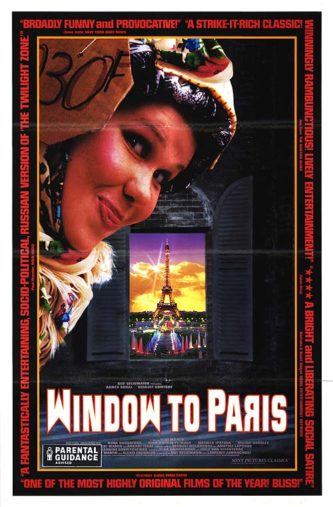 9. WINDOW TO PARIS (OKNO V PARIZH)
9. WINDOW TO PARIS (OKNO V PARIZH)
A wild, nutty and supremely engaging comedic fantasy about a Russian family who find a magic window in their apartment building that leads to Paris, France. Director Yuri Mamin exploits this slight-but-amusing premise for all it’s worth, with the Russians bringing all sorts of goodies back from Paris, a Parisian woman stumbling through the window into Russia and Russian schoolchildren going through the other way, with so many complications ensuing that after a while I wondered if it might not have been easier for these people to simply fly to Paris. Yes, the film has quite a few faults, but I’ll confess I was having too damn much fun watching it to care.
8. MOONLIGHT BOY (YUE GUANG SHAO NIAN)
Poetic, bizarre and altogether impressive quasi-horror from Taiwan that can be viewed as Asia’s answer to THE SIXTH SENSE. It centers on a strangely aloof young man who dispassionately wanders the streets of Taiwan. He’s a ghost who can only communicate with his mother and sister in dreams. In the meantime he hangs out in a spectral household run by a cartoon man and his dog, and chats with his long-deceased father. The eerie, subdued aura that pervades MOONLIGHT BOY is distinct and arresting; through deliberate pacing, uncluttered visuals and a disarmingly quiet soundtrack, director Yu Wei Yen creates a powerfully dreamlike atmosphere. He also provides a consistently surprising and unpredictable narrative packed with striking avant-garde elements. The periodic juxtaposition of live action and primitive animation is one such element, and while the mixture isn’t exactly up to ROGER RABBIT standards from a technical standpoint, it makes a considerable impression in its strangeness and audacity—as for that matter does MOONLIGHT BOY as a whole, a highly evocative, one-of-a-kind oddity that remains frustratingly obscure.
7. LIPSTICK ON YOUR COLLAR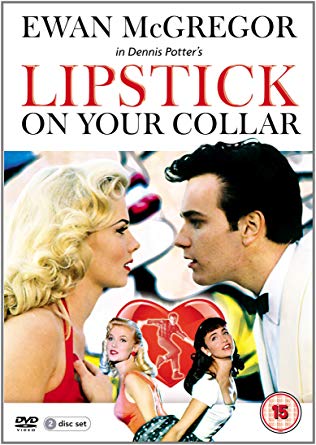
The final Dennis Potter scripted miniseries to be produced in Potter’s lifetime, LIPSTICK ON YOUR COLLAR is often dismissed by Potter-philes as a trifle, and indeed that’s just what it is. But it’s an extremely resonant and absorbing trifle, a comedic depiction of Potter’s early years, when he worked for Britain’s war office. A young Ewan McGregor plays one of three twentysomething daydreamers employed by the office, a notably stuffy and inhospitable environ. The daydreams in question are depicted in quintessential Potter fashion via the characters lip-syncing fifties pop tunes. Giles Thomas plays McGregor’s war office companion, an irrepressible goof who can’t ever seem to do anything right, and is in love with a sexy blonde played by the stunning Louise Germaine. Germaine, who was showcased quite prominently on the cover of the series’ American VHS release, joins Gina Bellman as a nineties-era Dennis Potter muse whose career never took off but who made a HUGE impression in his work (she also appeared in the Potter scripted MIDNIGHT MOVIE). These characters’ daydreams, romantic foibles and painful life lessons make for compelling viewing, in an affectionate and strikingly sexy portrayal of mid-Twentieth Century London that rings quite true. The only sore spot is the performance of Giles Thomas, whose cartoony emoting is at odds with the naturalistic acting of his fellows.
6. SHELF LIFE
A criminally neglected film if ever there was one. SHELF LIFE was one of the decade’s most brilliant comedies, but as it has yet to find distribution of any sort you most likely haven’t seen or even heard of it. It was a return to form for the late Paul Bartel (to early, edgy works like EATING RAOUL and PRIVATE PARTS, as opposed to later disappointments like SCENES FROM THE CLASS STRUGGLE IN BEVERLY HILLS and NOT FOR PUBLICATION), whose smartest decision was to stay out of the way of the writers/stars O-Lan Jones, Andrea Stein and Jim Turner. The film is based on their play about three kids whose loony parents shut them up in their family bomb shelter when JFK is assassinated. They spend the next thirty years in said shelter, creating a private universe based on childhood memories and the transmissions that occasionally come through their broken-down TV set. This is bizarre stuff, but also a wry commentary on early sixties culture, as the protagonists speak in a language composed mostly of phrases and references from that period. No, the film is not for everyone, and it’s often plain baffling, but you simply cannot deny the warped genius that suffuses it.
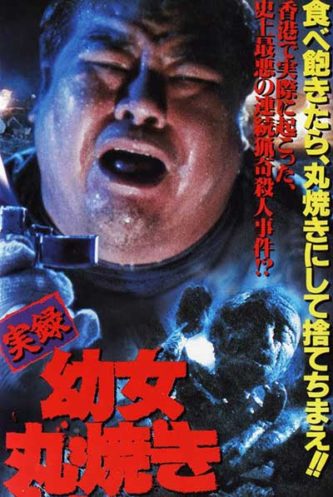 5. RUN AND KILL (WU SYU)
5. RUN AND KILL (WU SYU)
This Hong Kong production, hailing from the glory days of Category III (adults only) filmmaking, is one of the most exploitive, irresponsible and insane spectacles I’ve ever seen—in short, I loved it! Only a truly deranged mind could have concocted this hellaciously twisted tale of Fatty (Kent Cheng), a mild mannered slob who after catching his wife screwing another guy tells a hitman he wants her dead. Of course he means “dead drunk,” but that’s not how it comes out. This is the start of a series of outrageously violent convolutions involving a band of murderous debt-collectors and a pair of sibling mercenaries, one of whom is killed in the melee. This drives the surviving brother, played to psychotic perfection by Simon Yam, over the edge, and he comes after Fatty and his family. Before it’s all over Yam will have thrown Fatty’s aging mother out a window, set his young daughter on fire (afterwards parading the charred corpse before her horrified father while pantomiming “Daddy, why am I so dark?”), killed his own allies and turned Fatty into a raving lunatic. RUN AND KILL is either the blackest comedy ever made or one of the grimmest, most nihilistic thrillers of all time; either way, there’s never a dull moment.
4. DEADLY MARIA (DIE TODLICHE MARIA)
The first feature by Germany’s Tom Tykwer was this stunningly lensed exercise in surreal oppression. It’s decidedly grim, but also disquieting, provocative and deserving of wider exposure. Nina Petri is mighty impressive as the mousy Maria, who lives a Hellish existence in a nightmarish townhouse lorded over by her infirm father (Josef Bierbichler) and inattentive husband (Peter Franke). When not tending to the men’s needs Maria writes letters to herself and hides money inside a phallic statue (in anticipation of an escape from her unacceptable reality). She becomes drawn to Dieter (Joachim Krol), an eccentric man living in the downstairs apartment across the street; the two strike up a tentative romance, but it’s strictly a case of too little too late, as Maria’s ultimate path is a grim and violent one. DEADLY MARIA, with its assured and impressive craftsmanship, must be counted as among the most impressive filmmaking debuts of the nineties. Tom Tykwer, working with the skilled cinematographer Frank Griebe, incorporates all manner of stylistic quirks—innumerable dissolves and superimpositions, excessively bright and bold colors, overlapping dialogue, inanimate object POV shots, 360 degree pans, David Lynchian dream sequences—but the film never feels the least bit chaotic or disjointed. Rather, it has a smooth, confident flow, imparting a real sense of mounting desperation engendered by its all-too convincing depiction of Maria’s unquiet mind.
3. BAD BOY BUBBY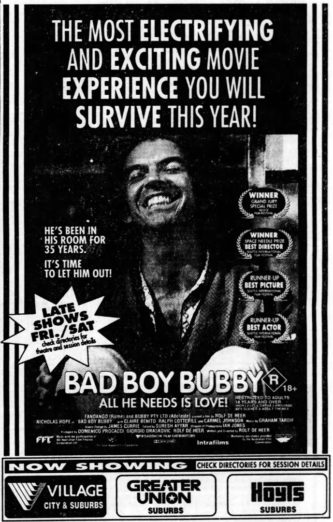
One of the great cult films of the nineties, a defiantly bizarre and grotesque variant on BEING THERE and FORREST GUMP. Bubby (Nicholas Hope) is a thirty five year old man who’s lived his entire life in a cell-like apartment presided over by his sadistic mother (Claire Benito), with whom he shares an incestuous bond. She’s convinced Bubby that if he sets foot outside he’ll choke to death on the air, so he never leaves–that is, until he suffocates his ma and her lover with cling wrap and finally ventures out. Writer-director Rolf De Heer pushes the agonizing claustrophobia of the early scenes as far as he possibly can, testing the thresholds of even the hardiest viewers. The action continues in a similarly twisted vein once Bubby enters the outside world, where he encounters a number of repulsive characters before finding true love with a plump woman (Carmel Johnson) who looks after impaired adults. Nicholas Hope gives a stunning performance as Bubby, who parrots whatever people say to him and always carries around his cling-wrapped cat, while De Heer’s filmmaking and wildly imaginative, free-form narrative manage to startle and subvert expectation at every turn. The central gimmick is that De Heer utilized thirty-three different cinematographers, one for each location encountered by Bubby, but the visuals have a uniformity to them and never feel mismatched.
2. THE LOTUS EATERS
Canada in the nineties wasn’t exactly known for turning out great cinema. Here’s an exception, a bittersweet comedy with quite a few pleasingly twisted moments (a dog brings a dead bird to a dinner table, a little girl interrupts a family gathering with instructions on how to sacrifice children). Set near the end of the 1950s, it’s about a repressed principal (R.H. Thomson) living on a backwoods island off the coast of British Columbia, an area referred to as “Lotus Land” by the famous Alfred Tennyson poem about people dreaming their lives away. Over the course of the film our none-too-heroic hero has an affair with a newly-employed beatnik teacher (Michele Barbara Pelletier), his wife (Sheila McCarthy) leaves him, his teenage daughter (Tara Frederick) is impregnated and everything goes to Hell…until the happy ending, of course. Anybody who’s ever spent time in Lotus Land (as I have) will immediately recognize the landscape and overall mood depicted here—rarely has a film ever captured the essence of a region with such spot-on immersion. And while there are some NORTHERN EXPOSURE-esque moments of forced cutesiness (as when McCarthy admits to using dog hair to knit a wool sweater) the photography is spectacular, with the land and surrounding ocean becoming characters in themselves.
 1. KING OF THE HILL
1. KING OF THE HILL
Steven Soderberg adapted A. E. Hotchner’s similarly titled memoir of growing up penniless during the Great Depression with seamless results. 13 year old Jesse Bradford is quite impressive as Aaron, an unusually resourceful tyke who always seems to have some obstacle to overcome: his home is a shitty hotel, his perpetually ailing mom (Lisa Eichorn) is sent to a sanitarium, his best friend (Adrien Brody) is a juvenile delinquent, the kids at his school are snobs and his loser father (Jeroen Krabbe) takes off to find work, leaving Aaron alone with hotel managers who want to lock him out. This is heavyweight subject matter that’s pulled off with unshowy yet consistently authentic period detail, but Soderberg, like Hotchner, keeps the tone lively, and includes plenty of endearingly quirky characters. Played by a supporting cast that includes Karen Allen, Spalding Gray, Elizabeth McGovern, a very young Katherine Heigl and a pre-Fugees Lauryn Hill, they help balance out the story’s darker elements, and make for what I contend is Soderberg’s masterpiece.
